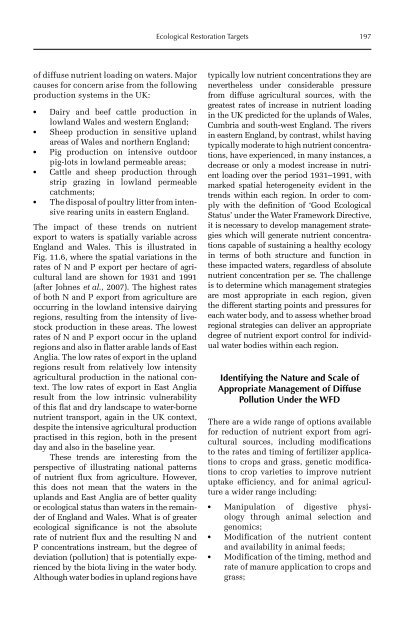Redesigning Animal Agriculture
Redesigning Animal Agriculture
Redesigning Animal Agriculture
Create successful ePaper yourself
Turn your PDF publications into a flip-book with our unique Google optimized e-Paper software.
of diffuse nutrient loading on waters. Major<br />
causes for concern arise from the following<br />
production systems in the UK:<br />
● Dairy and beef cattle production in<br />
lowland Wales and western England;<br />
● Sheep production in sensitive upland<br />
areas of Wales and northern England;<br />
● Pig production on intensive outdoor<br />
pig-lots in lowland permeable areas;<br />
● Cattle and sheep production through<br />
strip grazing in lowland permeable<br />
catchments;<br />
● The disposal of poultry litter from intensive<br />
rearing units in eastern England.<br />
The impact of these trends on nutrient<br />
export to waters is spatially variable across<br />
England and Wales. This is illustrated in<br />
Fig. 11.6, where the spatial variations in the<br />
rates of N and P export per hectare of agricultural<br />
land are shown for 1931 and 1991<br />
(after Johnes et al., 2007). The highest rates<br />
of both N and P export from agriculture are<br />
occurring in the lowland intensive dairying<br />
regions, resulting from the intensity of livestock<br />
production in these areas. The lowest<br />
rates of N and P export occur in the upland<br />
regions and also in flatter arable lands of East<br />
Anglia. The low rates of export in the upland<br />
regions result from relatively low intensity<br />
agricultural production in the national context.<br />
The low rates of export in East Anglia<br />
result from the low intrinsic vulnerability<br />
of this flat and dry landscape to water-borne<br />
nutrient transport, again in the UK context,<br />
despite the intensive agricultural production<br />
practised in this region, both in the present<br />
day and also in the baseline year.<br />
These trends are interesting from the<br />
perspective of illustrating national patterns<br />
of nutrient flux from agriculture. However,<br />
this does not mean that the waters in the<br />
uplands and East Anglia are of better quality<br />
or ecological status than waters in the remainder<br />
of England and Wales. What is of greater<br />
ecological significance is not the absolute<br />
rate of nutrient flux and the resulting N and<br />
P concentrations instream, but the degree of<br />
deviation (pollution) that is potentially experienced<br />
by the biota living in the water body.<br />
Although water bodies in upland regions have<br />
Ecological Restoration Targets 197<br />
typically low nutrient concentrations they are<br />
nevertheless under considerable pressure<br />
from diffuse agricultural sources, with the<br />
greatest rates of increase in nutrient loading<br />
in the UK predicted for the uplands of Wales,<br />
Cumbria and south-west England. The rivers<br />
in eastern England, by contrast, whilst having<br />
typically moderate to high nutrient concentrations,<br />
have experienced, in many instances, a<br />
decrease or only a modest increase in nutrient<br />
loading over the period 1931–1991, with<br />
marked spatial heterogeneity evident in the<br />
trends within each region. In order to comply<br />
with the definition of ‘Good Ecological<br />
Status’ under the Water Framework Directive,<br />
it is necessary to develop management strategies<br />
which will generate nutrient concentrations<br />
capable of sustaining a healthy ecology<br />
in terms of both structure and function in<br />
these impacted waters, regardless of absolute<br />
nutrient concentration per se. The challenge<br />
is to determine which management strategies<br />
are most appropriate in each region, given<br />
the different starting points and pressures for<br />
each water body, and to assess whether broad<br />
regional strategies can deliver an appropriate<br />
degree of nutrient export control for individual<br />
water bodies within each region.<br />
Identifying the Nature and Scale of<br />
Appropriate Management of Diffuse<br />
Pollution Under the WFD<br />
There are a wide range of options available<br />
for reduction of nutrient export from agricultural<br />
sources, including modifications<br />
to the rates and timing of fertilizer applications<br />
to crops and grass, genetic modifications<br />
to crop varieties to improve nutrient<br />
uptake efficiency, and for animal agriculture<br />
a wider range including:<br />
● Manipulation of digestive physiology<br />
through animal selection and<br />
genomics;<br />
● Modification of the nutrient content<br />
and availability in animal feeds;<br />
● Modification of the timing, method and<br />
rate of manure application to crops and<br />
grass;










